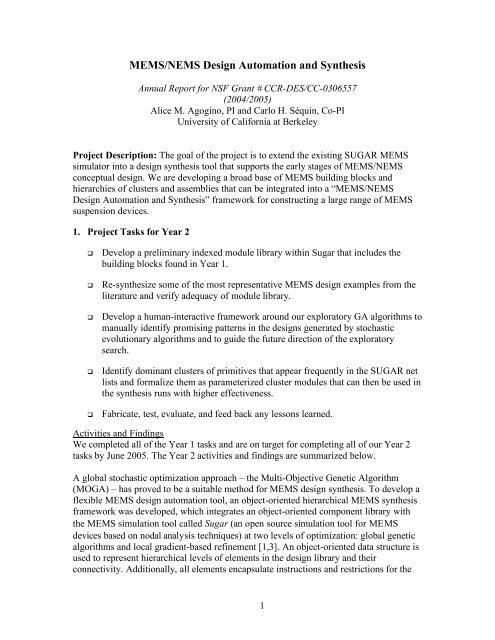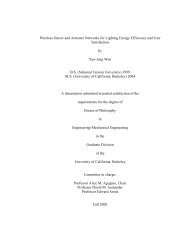MEMS/NEMS Design Automation and Synthesis - University of ...
MEMS/NEMS Design Automation and Synthesis - University of ...
MEMS/NEMS Design Automation and Synthesis - University of ...
You also want an ePaper? Increase the reach of your titles
YUMPU automatically turns print PDFs into web optimized ePapers that Google loves.
<strong>MEMS</strong>/<strong>NEMS</strong> <strong>Design</strong> <strong>Automation</strong> <strong>and</strong> <strong>Synthesis</strong><br />
Annual Report for NSF Grant # CCR-DES/CC-0306557<br />
(2004/2005)<br />
Alice M. Agogino, PI <strong>and</strong> Carlo H. Séquin, Co-PI<br />
<strong>University</strong> <strong>of</strong> California at Berkeley<br />
Project Description: The goal <strong>of</strong> the project is to extend the existing SUGAR <strong>MEMS</strong><br />
simulator into a design synthesis tool that supports the early stages <strong>of</strong> <strong>MEMS</strong>/<strong>NEMS</strong><br />
conceptual design. We are developing a broad base <strong>of</strong> <strong>MEMS</strong> building blocks <strong>and</strong><br />
hierarchies <strong>of</strong> clusters <strong>and</strong> assemblies that can be integrated into a “<strong>MEMS</strong>/<strong>NEMS</strong><br />
<strong>Design</strong> <strong>Automation</strong> <strong>and</strong> <strong>Synthesis</strong>” framework for constructing a large range <strong>of</strong> <strong>MEMS</strong><br />
suspension devices.<br />
1. Project Tasks for Year 2<br />
<br />
<br />
<br />
<br />
<br />
Develop a preliminary indexed module library within Sugar that includes the<br />
building blocks found in Year 1.<br />
Re-synthesize some <strong>of</strong> the most representative <strong>MEMS</strong> design examples from the<br />
literature <strong>and</strong> verify adequacy <strong>of</strong> module library.<br />
Develop a human-interactive framework around our exploratory GA algorithms to<br />
manually identify promising patterns in the designs generated by stochastic<br />
evolutionary algorithms <strong>and</strong> to guide the future direction <strong>of</strong> the exploratory<br />
search.<br />
Identify dominant clusters <strong>of</strong> primitives that appear frequently in the SUGAR net<br />
lists <strong>and</strong> formalize them as parameterized cluster modules that can then be used in<br />
the synthesis runs with higher effectiveness.<br />
Fabricate, test, evaluate, <strong>and</strong> feed back any lessons learned.<br />
Activities <strong>and</strong> Findings<br />
We completed all <strong>of</strong> the Year 1 tasks <strong>and</strong> are on target for completing all <strong>of</strong> our Year 2<br />
tasks by June 2005. The Year 2 activities <strong>and</strong> findings are summarized below.<br />
A global stochastic optimization approach – the Multi-Objective Genetic Algorithm<br />
(MOGA) – has proved to be a suitable method for <strong>MEMS</strong> design synthesis. To develop a<br />
flexible <strong>MEMS</strong> design automation tool, an object-oriented hierarchical <strong>MEMS</strong> synthesis<br />
framework was developed, which integrates an object-oriented component library with<br />
the <strong>MEMS</strong> simulation tool called Sugar (an open source simulation tool for <strong>MEMS</strong><br />
devices based on nodal analysis techniques) at two levels <strong>of</strong> optimization: global genetic<br />
algorithms <strong>and</strong> local gradient-based refinement [1,3]. An object-oriented data structure is<br />
used to represent hierarchical levels <strong>of</strong> elements in the design library <strong>and</strong> their<br />
connectivity. Additionally, all elements encapsulate instructions <strong>and</strong> restrictions for the<br />
1
genetic operations <strong>of</strong> mutation <strong>and</strong> crossover. The parameterized component library<br />
includes distinct low-level primitive elements <strong>and</strong> high-level clusters <strong>of</strong> primitive<br />
elements [15]. In our case-based framework, the component library, including fabrication<br />
<strong>and</strong> simulation constraints, are updated as new designs are tested <strong>and</strong> evaluated (see<br />
Figure 1).<br />
During the past year we developed <strong>and</strong> tested a human-interactive framework around GA<br />
algorithms called <strong>MEMS</strong>-Interactive-Evolutionary Computation (<strong>MEMS</strong>-IEC). It gives a<br />
human designer an option to select <strong>and</strong> further evolve designs generated by our existing<br />
stochastic techniques. It allows a user to include human judgment <strong>and</strong> design experience<br />
as an integral part <strong>of</strong> the simulation s<strong>of</strong>tware’s assessment <strong>of</strong> designs performance, thus<br />
addressing design factors that are hard to simulate with modified nodal analyses, such as<br />
stress concentrations <strong>and</strong> dynamic interference [2]. The IEC approach for <strong>MEMS</strong> <strong>Design</strong><br />
synthesis is currently under review for a patent application [18].<br />
A starting base <strong>of</strong> existing <strong>MEMS</strong> designs has been identified from the literature <strong>and</strong><br />
indexed into a preliminary <strong>MEMS</strong> module library [8,14]. These designs have been<br />
broken down into basic elements <strong>and</strong> clusters in parameterized form. The SUGAR net<br />
lists for object-oriented building blocks have been created <strong>and</strong> will be released in the next<br />
year with the next update <strong>of</strong> the SUGAR s<strong>of</strong>tware. We will make new building blocks in<br />
SUGAR freely available through source code, documentation, as well as a web service.<br />
In analyzing clusters <strong>and</strong> patterns <strong>of</strong> features from published <strong>MEMS</strong> designs, we<br />
identified the need to develop a curved beam element. The curved beam is needed to<br />
effectively develop clusters like spiral springs <strong>and</strong> circular rings. The two-node six-degree<br />
<strong>of</strong> freedom element being developed takes the effects <strong>of</strong> flexural, axial <strong>and</strong> shear<br />
deformation into account using a hybrid-mixed formulation based on the Hellinger-<br />
Reissner variational principle. The accuracy <strong>of</strong> the method is being verified with st<strong>and</strong>ard<br />
test problems <strong>and</strong> exact solutions from the theory <strong>of</strong> elasticity. Further testing <strong>of</strong> the<br />
numerical results will be compared with those obtained from finite element analyses. To<br />
date, the curved beam element in these calculations shows very good convergence results.<br />
After testing <strong>and</strong> validation, the curved beam formulation will be added to the indexed<br />
element <strong>and</strong> case database. [16]<br />
A wide range <strong>of</strong> MOGA-generated <strong>MEMS</strong> resonating masses have been fabricated <strong>and</strong><br />
characterized to validate our use <strong>of</strong> SUGAR as an effective evaluation engine, <strong>and</strong> to<br />
better underst<strong>and</strong> the constraints <strong>and</strong> objectives necessary for accurate synthesis. A testfeedback<br />
strategy was developed for improving evolutionary synthesis based on the<br />
results from the fabrication <strong>and</strong> characterization <strong>of</strong> output from our GA-based synthesis<br />
program. Simulator <strong>and</strong> fabrication conditions lead to certain configurations <strong>of</strong> output<br />
differing significantly from predicted performance when fabricated <strong>and</strong> measured. Using<br />
lessons learned from a <strong>MEMS</strong> synthesis characterization study, four modifications to the<br />
objectives <strong>and</strong> constraint settings <strong>of</strong> the GA formulation are evaluated to produce results<br />
that more closely match desired performance when fabricated. Through the<br />
characterization, we have been able to classify the results into three groups: 1) designs<br />
where the measured performance matches the simulation accurately; 2) designs where the<br />
2
simulation differs from measured data due to simulator limitations, <strong>and</strong> 3) designs where<br />
the simulations differ from measured data due to fabrication variations. By studying these<br />
groups, we were able to identify deficiencies in our current synthesis encoding <strong>and</strong><br />
suggest additional constraints or objectives that will lead to better designs in the future.<br />
To date, statistical tests show improvement in the quality <strong>of</strong> the GA’s output, producing<br />
designs with significantly less simulation <strong>and</strong> fabrication errors using the proposed<br />
methods. [3,17].<br />
Eighteen publications reflecting the research partially supported by this grant are listed<br />
below. This list includes two completed MS theses [14,15] <strong>and</strong> one PhD dissertation [17]<br />
completed in the last year. Another MS thesis/project is expected to be completed by the<br />
end <strong>of</strong> the Spring 2005 semester [16].<br />
Knowledge Base <strong>and</strong><br />
Component Library<br />
Casebased<br />
Indexed<br />
<strong>Design</strong><br />
Library<br />
Fabrication<br />
Constraints<br />
Simulation<br />
Constraints<br />
Evaluation,<br />
Validation &<br />
Refinement <strong>of</strong><br />
<strong>Design</strong> Rules<br />
Finite<br />
Element<br />
Analyses<br />
(FEM)<br />
Fabrication,<br />
Testing &<br />
Characterization<br />
<strong>Design</strong><br />
Encoding<br />
Scheme<br />
Initial<br />
<strong>Design</strong>(s)<br />
Evolutionary<br />
<strong>Synthesis</strong><br />
Algorithm<br />
Optional: Local<br />
Optimization (human<br />
interactive or gradient<br />
based methods)<br />
Synthesized<br />
<strong>Design</strong>s<br />
<strong>Design</strong> Objectives<br />
Constraints<br />
Simulation<br />
Engine<br />
Figure 1: <strong>Design</strong> <strong>Synthesis</strong> Module<br />
2. Training <strong>and</strong> Development<br />
The grant has supported a weekly interdisciplinary <strong>MEMS</strong>/<strong>NEMS</strong> CAD seminar with<br />
3
approximately 15 graduate students <strong>and</strong> 5 faculty.<br />
3. Outreach Activities<br />
As this research is conducted through the Berkeley Sensors <strong>and</strong> Actuator Center (BSAC),<br />
bi-annual reports, posters <strong>and</strong> presentations have also been provided to the industrial<br />
community [5-13].<br />
4. Contributions within Discipline<br />
The main focus <strong>of</strong> the grant is in electrical <strong>and</strong> mechanical engineering as well as<br />
computer science.<br />
5. Contributions to Other Disciplines<br />
Contributions to evolutionary algorithms for computer-aided design.<br />
6. Contributions to Human Resource Development<br />
Support for 6 graduate students.<br />
7. Contributions to Resources for Research <strong>and</strong> Education<br />
Examples <strong>of</strong> <strong>MEMS</strong> cases have been added to the NEEDS digital library <strong>of</strong> educational<br />
resources at www.needs.org (search over the series – <strong>MEMS</strong> <strong>Design</strong> Cases).<br />
8. Contributions Beyond Science <strong>and</strong> Engineering<br />
None yet.<br />
9. Publications <strong>and</strong> Presentations (to date)<br />
Journals<br />
None yet.<br />
Conference Proceedings<br />
1. Kamalian, R., A.M. Agogino <strong>and</strong> H. Takagi, “The Role Of Constraints <strong>and</strong><br />
Human Interaction in Evolving <strong>MEMS</strong> <strong>Design</strong>s: Microresonator Case Study,”<br />
Proceedings <strong>of</strong> DETC'04, ASME 2004 <strong>Design</strong> Engineering Technical Conference,<br />
<strong>Design</strong> <strong>Automation</strong> track, Paper # DETC2004-57462, CD ROM, ISBN # I710CD.<br />
2. Kamalian, R., H. Takagi, <strong>and</strong> A.M. Agogino, “Optimized <strong>Design</strong> <strong>of</strong> <strong>MEMS</strong> by<br />
Evolutionary Multi-objective Optimization with Interactive Evolutionary<br />
Computation," Proceedings <strong>of</strong> the GECCO 2004 (Genetic <strong>and</strong> Evolutionary<br />
Computation Conference; June 26-30, 2004, Seattle, Washington), ISBN # is 3-<br />
540-22343-6, Vol. 2, pp. 1030-1041, 2004.<br />
3. Zhang, Y., R. Kamalian, A.M. Agogino <strong>and</strong> C.H. Séquin, "Hierarchical <strong>MEMS</strong><br />
<strong>Synthesis</strong> <strong>and</strong> Optimization," SPIE Conference on Smart Structures <strong>and</strong><br />
Materials, Paper No. 5763-12, March 7-10, 2005, San Diego CA.<br />
4
4. Kamalian, R. <strong>and</strong> A.M. Agogino, "Improving Evolutionary <strong>MEMS</strong> <strong>Synthesis</strong><br />
through Fabrication <strong>and</strong> Testing Feedback", submitted to IEEE SMC2005. (under<br />
review)<br />
Reports<br />
5. Kamalian, Raffi, Alice M. Agogino, James Demmel, “<strong>MEMS</strong> <strong>Synthesis</strong> Using<br />
Stochastic Optimization”, (Berkeley Sensor <strong>and</strong> Actuator Center Researchers’<br />
Industrial Advisory Board, September 2003).<br />
6. Kamalian, Raffi, Alice M. Agogino, James Demmel, “<strong>MEMS</strong> <strong>Synthesis</strong> Using<br />
Stochastic Optimization”, (Berkeley Sensor <strong>and</strong> Actuator Center Researchers’<br />
Industrial Advisory Board, March 2004).<br />
7. Kamalian, Raffi, Ying Zhang, Alice M. Agogino, James Demmel, “<strong>MEMS</strong><br />
<strong>Synthesis</strong> Using Stochastic Optimization” (Berkeley Sensor <strong>and</strong> Actuator Center<br />
Researchers’ Industrial Advisory Board, September 2004).<br />
8. Cobb, Corie, Ying Zhang, Alice M. Agogino, Carlo H. Séquin <strong>and</strong> K. Pister,<br />
"<strong>MEMS</strong> <strong>Design</strong> <strong>Synthesis</strong> <strong>and</strong> Optimization", (Berkeley Sensor <strong>and</strong> Actuator<br />
Center Researchers’ Industrial Advisory Board, March 2005).<br />
Presentations<br />
9. Kamalian, Raffi , Poster, “<strong>MEMS</strong> <strong>Synthesis</strong> Using Stochastic Optimization”,<br />
(Berkeley Sensor <strong>and</strong> Actuator Center Researchers’ Industrial Advisory Board,<br />
September 2003).<br />
10. Kamalian, Raffi , Poster, “<strong>MEMS</strong> <strong>Synthesis</strong> Using Stochastic Optimization”,<br />
(Berkeley Sensor <strong>and</strong> Actuator Center Researchers’ Industrial Advisory Board,<br />
March 2004).<br />
11. Kamalian, Raffi, Technical Presentation “<strong>MEMS</strong> Simulation <strong>and</strong> <strong>Synthesis</strong>:<br />
Sensors & RF Applications II: Automated <strong>Synthesis</strong> <strong>of</strong> <strong>MEMS</strong>”, (Berkeley<br />
Sensor <strong>and</strong> Actuator Center Researchers’ Industrial Advisory Board, September<br />
2004).<br />
12. Kamalian, Raffi, Poster, “<strong>MEMS</strong> <strong>Synthesis</strong> Using Stochastic Optimization”,<br />
(Berkeley Sensor <strong>and</strong> Actuator Center Researchers’ Industrial Advisory Board,<br />
September 2004).<br />
13. Cobb, Corie, Poster, “<strong>MEMS</strong> <strong>Design</strong> <strong>Synthesis</strong> <strong>and</strong> Optimization”, (Berkeley<br />
Sensor <strong>and</strong> Actuator Center Researchers’ Industrial Advisory Board, March<br />
2005).<br />
MS Theses/Reports<br />
14. Zarif, M.R., "Categorization <strong>of</strong> Current <strong>MEMS</strong> Suspension <strong>Design</strong> Variants," MS<br />
Plan II report, Spring 2004, Department <strong>of</strong> Mechanical Engineering, <strong>University</strong> <strong>of</strong><br />
California at Berkeley.<br />
15. Graf, S., “GA Building Blocks <strong>and</strong> Data Structures for <strong>MEMS</strong>/<strong>NEMS</strong> <strong>Design</strong><br />
<strong>Automation</strong> <strong>and</strong> <strong>Synthesis</strong>,” Diploma Thesis, Department <strong>of</strong> Computer Science,<br />
5
RWTH Aachen (in cooperation with the Department <strong>of</strong> Mechanical Engineering,<br />
<strong>University</strong> <strong>of</strong> California, Berkeley), Oct. 2004.<br />
16. Ranganathan, V., "Locking-free Curved Beam Finite Element Formulation for<br />
<strong>MEMS</strong> <strong>Synthesis</strong>", Spring 2005, Department <strong>of</strong> Mechanical Engineering,<br />
<strong>University</strong> <strong>of</strong> California at Berkeley (expected April, 2005).<br />
PhD Dissertations<br />
Patents<br />
17. Kamalian, R., "Evolutionary <strong>Synthesis</strong> <strong>of</strong> <strong>MEMS</strong> Devices," Doctoral<br />
Dissertation, Fall 2004, Department <strong>of</strong> Mechanical Engineering, <strong>University</strong> <strong>of</strong><br />
California at Berkeley.<br />
18. A.M. Agogino, R. Kamalian, <strong>and</strong> H. Takagi, Engineering <strong>Design</strong> System Using<br />
Human Interactive Evaluation, U.C. Case No. B05-029-1, Attorney Docket No.<br />
010030-000600US. (under review).<br />
6
















